A construction accident report is a crucial sample document that details unfortunate incidents at construction sites. These reports serve to document the specifics of accidents, including date, time, location,…
continue reading29+ Sample New Hire Orientation Checklists
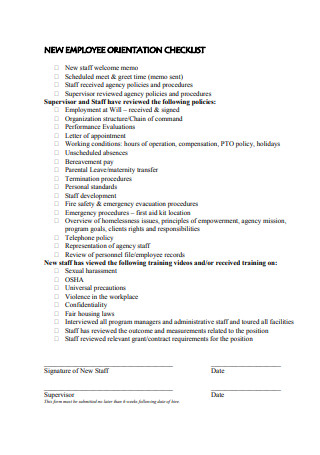
New Employee Orientation Checklist
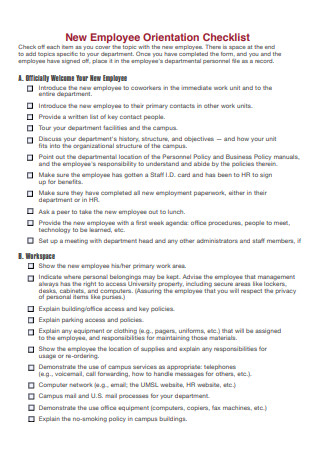
Sample New Employee Orientation Checklist
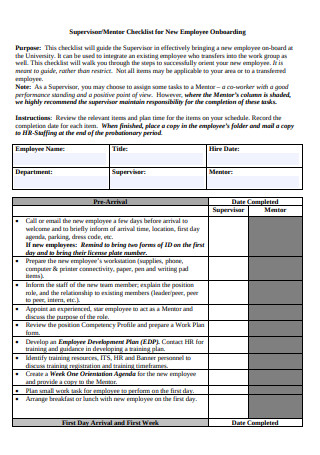
Supervisor’s Checklist for New Employee Orientation
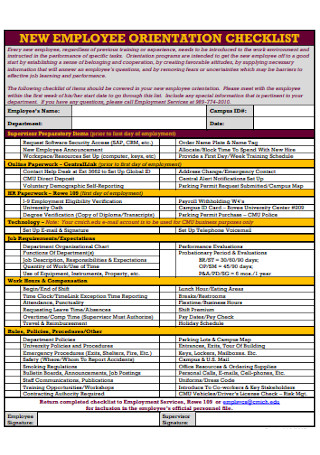
New Hire Checklist
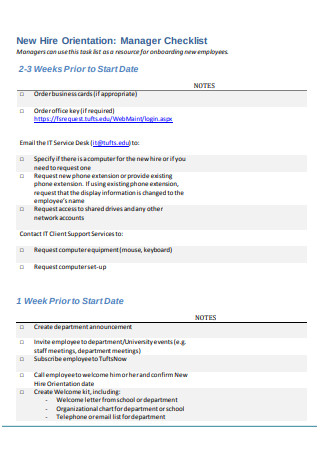
New Hire Orientation- Manager Checklist
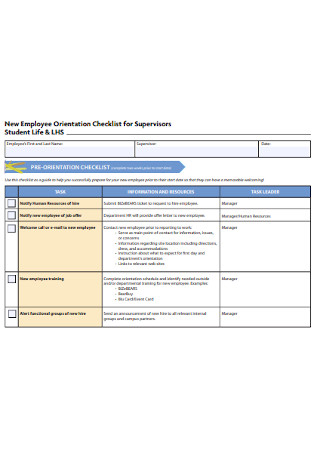
New Employee Orientation Checklist for Supervisors

Supervisor Checklist for New Employee Orientation
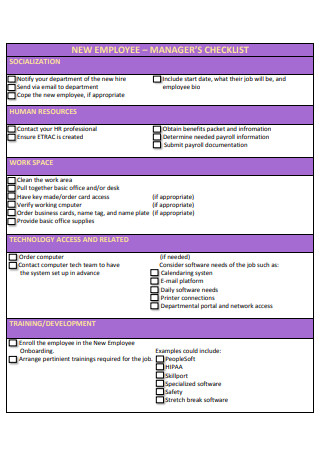
Onboarding Manager Checklist
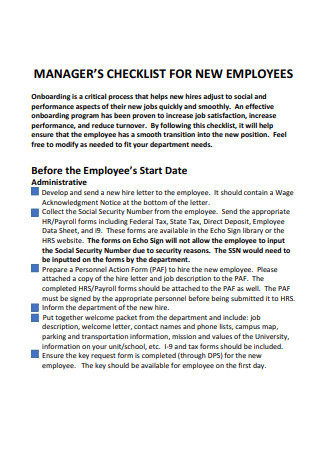
Manager’s Checklist For New Employees
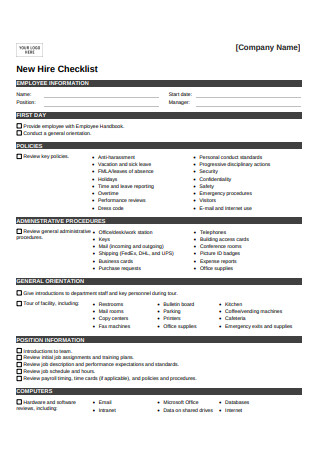
New Hire Orientation Checklist
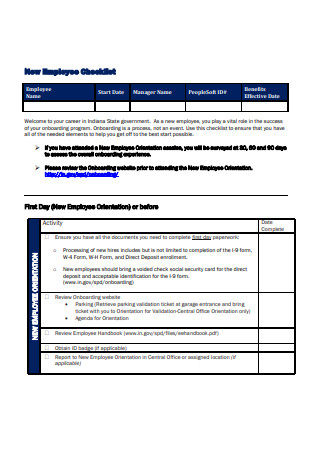
New Employee Checklist
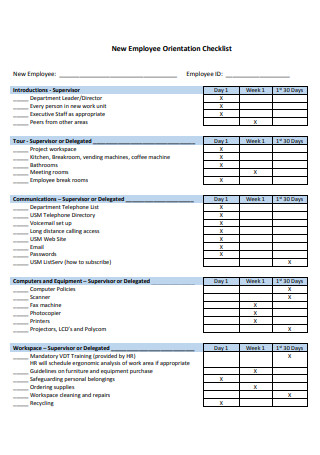
Formal New Employee Orientation Checklist
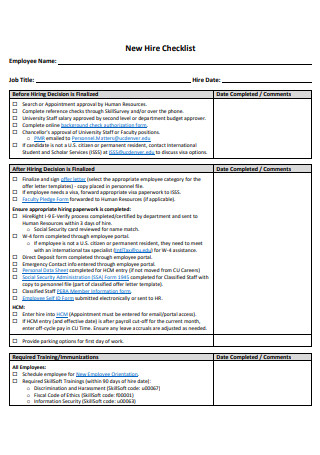
Simple New Hire Checklist
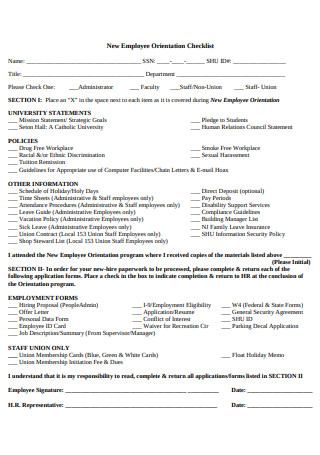
Printable New Employee Orientation Checklist
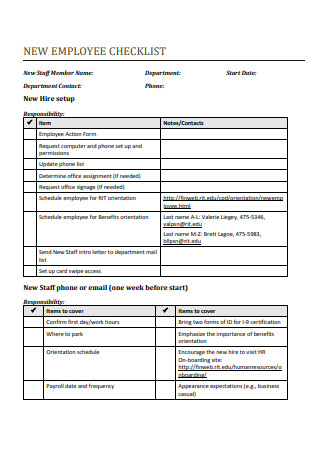
New Employee Checklist Sample
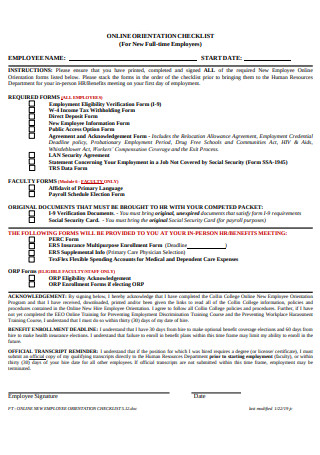
Online Orientation Checklist
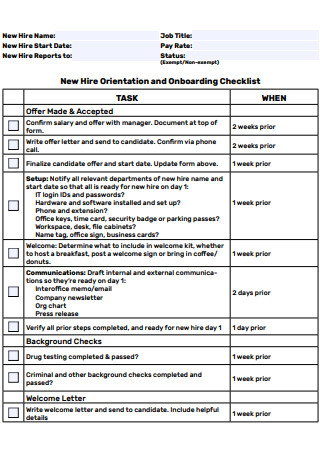
New Hire Orientation and Onboarding Checklist
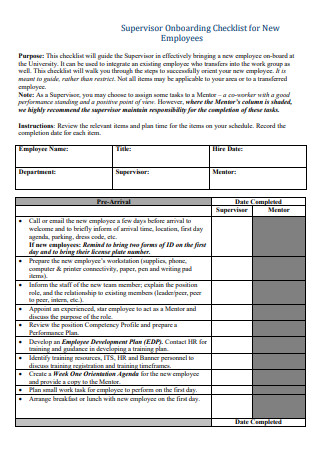
Supervisor Onboarding Checklist for New Employees
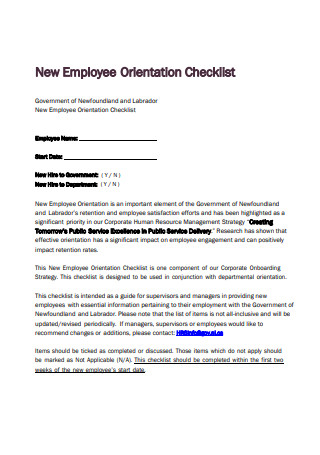
Simple New Employee Orientation Checklist
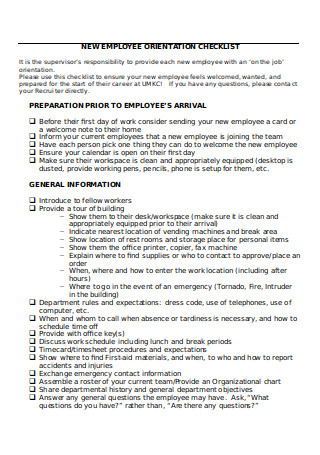
New Employee Orientation Checklist Format
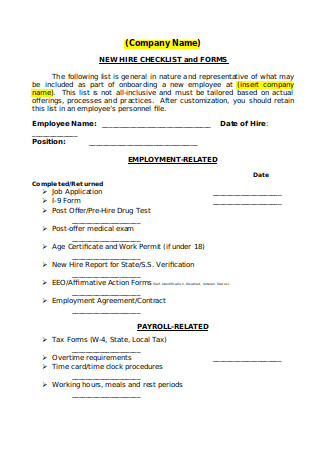
New Hire Checklist in DOC
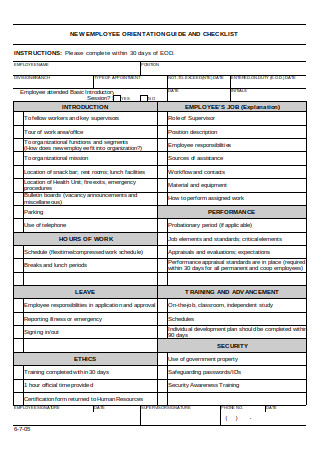
New Employee Orientation Guide and Checklist
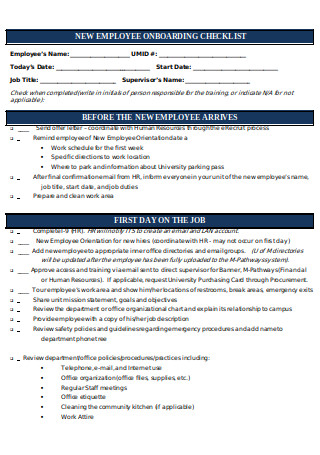
New Employee Onboarding Checklist

Departmental Checklist for New Employees
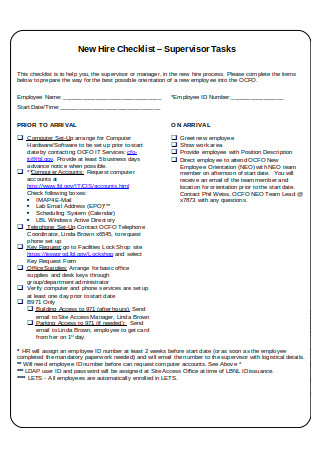
New Hire Checklist Format
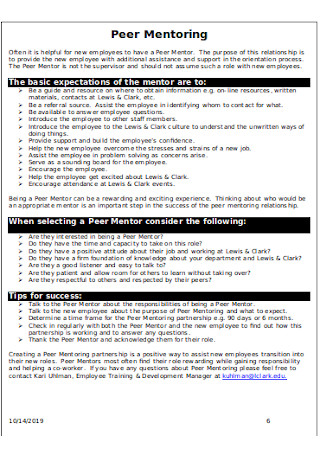
Department Orientation Checklist

New Hire Orientation Checklist in DOC
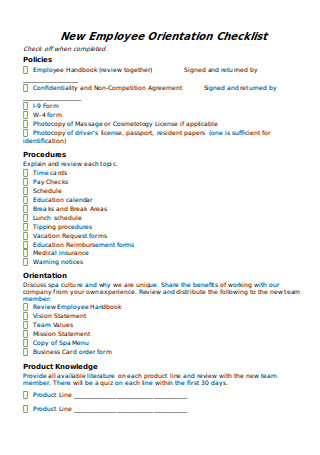
New Employee Orientation Checklist in DOC
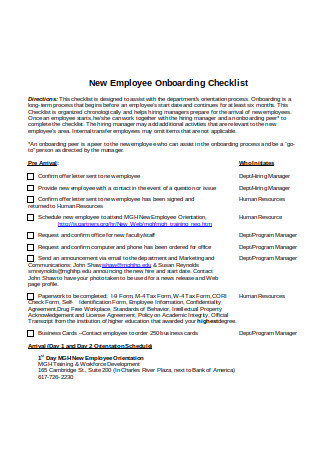
New Employee Onboarding Checklist Sample
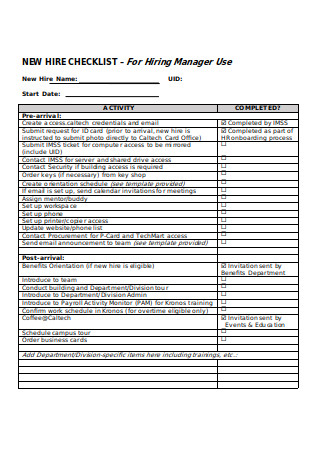
Format of New Hire Checklist
What Is a New Hire Orientation Checklist?
A new hire orientation checklist is a kind of checklist that aids the Human Resources department during the onboarding process of new employees. During the new hire orientation, the company is responsible for helping new hires to adjust to their new work environment, to learn essential company rules, regulations, and policies, and to help them prepare in taking on the job responsibilities at hand. Other than that, new hires should fill out forms required by the law during their orientation. With all the tasks that need to be carried out, one can get overwhelmed. But with the use of a checklist, the one handling the orientation is guided continuously throughout.

Duration of a New Hire Orientation
An orientation program can be as short as 2 to 3 hours and as long as a week. The length of an orientation program depends on the job position the new hire is taking over. Other than that, it also depends on the amount of information that needs to be relayed by the company. See to it that you do not keep feeding new information to the new hires just to fit the orientation within the day. Introducing too much information at once causes information overload; chances are, they won’t even cannot effectively retain it all. Extend the orientation if there is a need to do so.
Importance of a New Hire Orientation Checklist
Soon enough, the United States will have more job vacancies than applicants. The Washington Post reports that in March 2018, there were 6.6 million job openings which are already enough for the 6.6 million US job seekers. But despite these numbers, a lot of businesses are worrying about not getting enough people to fill job vacancies. That is why when you acquire even one or two new hires, you should exhaust all your means and ways to make them stay. As simple as a new hire orientation checklist can make a difference. Such type of checklist assures new hires that the individuals assigned to handle the onboarding process can provide a holistic orientation that creates a positive impact on the new hires on their very first day of work.
What to Include in a New Hire Orientation Checklist
A new hire orientation checklist is not only beneficial for the one responsible for handling the orientation, but new hires can also benefit from this. This kind of checklist ensures that crucial tasks?such as introducing the people and the culture of the company?are not forgotten. To create a thorough new hire orientation checklist that will indeed be beneficial for both parties, learn the basic checklist contents that you must incorporate in your checklist below.
How to Create a New Hire Orientation Checklist
Creating a new hire orientation checklist shouldn’t be complicated and overwhelming. All you need to know are the simple steps that allow you to come up even with the most basic checklist. That said, below are easy-to-follow steps that will keep you guided upon making your own checklist.
Step 1: Download and Customize a Ready-Made Templates
Using a ready-made checklist template allows you to save time, money, and effort. Instead of getting worked up about how to create one of your own from scratch, a template can save you from all the worries. The internet is a vast source of quality templates. Simply choose a reliable source to download from, such as this very article you’re reading, and you are good to go. Unfortunately, as much as you want to use a template as is, you might find the need to customize its contents further to suit your needs.
Step 2: Determine the Checklist Items You Need to Secure
Above, you can find suggested checklist items that any standard or basic new hire orientation checklist must contain. See to it that the checklist items you incorporate enable employees to fill out all the necessary paperwork required by the company and the law, meet the members of their assigned team or department, learn the essential company policies, and settle into the new working environment. Ensure that you can list down all of the crucial things that you need to be reminded of during the actual orientation program. Keep in mind that the orientation program is the first step of every employee boarding process. The new hire orientation can make or break the groundwork for a problem-free onboarding process.
Step 3: Proof and Finalize
As soon as you have already covered all the basics, it’s time for you to proofread every single content you incorporated in your template. Be sure to look out for grammatical and typographical errors. Take some time away from your checklist draft so you can come back to it with a fresher perspective and notice the mistakes you missed prior to taking a break. Other than that, you can ask someone to review and run things through on your behalf.
The Dos and Don’ts of a New Hire Orientation
In order to create a practical orientation checklist, it is essential for you to know the dos and don’ts of every new hire orientations. That said, take note of the following dos and don’ts we have listed below to keep you guided.
Dos
1. Do know the difference between separate orientation and onboarding.
Contrary to what most people think, new hire orientation is different from onboarding although it is a part of the onboarding process. It is essential to know its difference so you will know what to include in your orientation program checklist. During orientation, you teach new hires about the company, policies, management structure, benefits, and other necessary information need to have a full grasp regarding their employment. During an onboarding process, you introduce new hires to the brand, company culture, and work environment. Orientation takes only a day or even a couple of hours to complete. Onboarding processes take months.
2. Do keep your professionalism during the new hire orientation.
You were once a newbie in the workplace and you, of all people, should already know how it feels like. If the one who handled your orientation acted like it was an inconvenience having to deal with you, avoid acting like that person at all costs. See to it that the new hires will receive a warm welcome from you. Make sure that they feel free to ask you with followup questions instead of asking their fellow new hires who equally know nothing.
3. Do inform the arrival of the new hire.
Even if you are only expecting one new hire to join the team, you must inform the members, security staff, and other key individuals in the company about their arrival. Just give out the new hire’s necessary information such as their name, the time they will get in the office, and what position they will hold. In doing so, new hires can avoid getting into any misunderstanding with the security staff or with the people whom they will be working with.
4. Do prepare a clear agenda and schedule.
A new hire orientation checklist is pointless if you don’t prepare an agenda and schedule beforehand. With an agenda and schedule, you will not forget important tasks such as touring the new hiring around the workplace, showing them their cubicle or table, and introducing them to their teammates and key individuals in the company. Another benefit you can get from an agenda and schedule is that you can make the orientation process easy for the new hires to take and also for you to break the process into manageable chunks.
Donts
1. Don’t put new hires into a trial and error.
A famous proverb may say that experience is the best teacher, but this does not apply when it comes to orienting new hires with the rules, regulations, or policies of the company. Avoid circumstances wherein new hires commit honest mistakes simply because you forgot to inform them about a specific rule or policy. Don’t make the new hires learn the rules by experiencing a trial and error. For instance, new hires arrive at work at 8:00 AM sharp when the attendance plan policy of the company states that they should clock in ten minutes before the time.
2. Don’t leave it all up to the HR department.
Even if you are not from the Human Resources Department, you must consider welcoming the new employees in your department or team as your responsibility. Leaving the orientation all up to the HR department have downsides. The HR department plan has little to no knowledge regarding the skills required in your department and has no idea at all on how to orient the new hire about the specific tasks of the department. You may also see this as an avenue where you and the rest of the team can start building rapport with the team.
3. Don’t expect new hires to learn everything in one go.
Brains are likened to that of a sponge where the absorption of knowledge and information continually happens. However, unlike sponges, we cannot always do desorption where we effortlessly create space for new learning. That is why you must now require new hires to learn the policies and the rest of the employee handbook on their first day at work. Give them ample amount of time to learn the critical policies. Never expect them to learn everything in one go.
4. Don’t miss checking in with the new hires.
It is vital to continually check and see how the new hires are adjusting to the work environment. Consider having engaging orientation events throughout their first week at work so they can gradually settle in the company. By doing so, you show that the company is concerned about them. Constantly checking on the new hires lessens any circumstances wherein they would no longer report for work in their second week.
5. Don’t make new hires focus on things they are not allowed to do.
If your company is one of those who strongly emphasize the things that employees should avoid at all costs, then maybe it’s time for you to change some things around. Focusing on how to prevent issues and problems to happen in the workplace alone would not make employees learn about what they can do. Relay to them the fun things that they can do in the workplace. Share them engaging ways they can improve their productivity and quality of work. It is vital to have a holistic approach in introducing both the dos and don’ts of the company to the employees so they will have an equally holistic viewpoint toward these.
Make every new hire’s orientation process smooth by downloading any of the new hire orientation checklist templates and examples that are uploaded above. However, no template has a one-size-fits-all content so see to it that you further customize any of these templates according to your state laws and company requirements.

